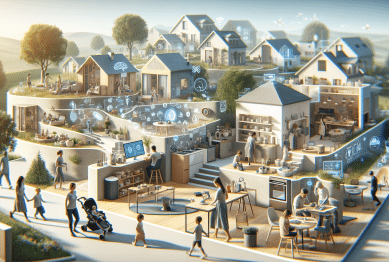In 2025, smart home technologies are revolutionizing how we live, blending convenience, efficiency, and sustainability into everyday spaces. Fueled by advancements in AI, IoT, and connectivity standards like Matter, these innovations transform homes into intelligent, responsive environments. Drawing on insights from sustainable home practices and 2025 interior design trends, this article explores the rise of smart home technologies, their key applications, and practical strategies to integrate them for a smarter, more comfortable home.

Why Smart Home Technologies Matter in 2025
Smart home technologies enhance convenience, security, and energy efficiency while supporting wellness and sustainability. In 2025, with a projected market size exceeding 135 billion and growing at a 27.3% CAGR, these systems are becoming essential for modern living, catering to diverse needs from remote work to aging-in-place solutions. By leveraging AI and seamless device integration, homeowners can create spaces that anticipate needs and align with eco-conscious values.
Key Smart Home Technologies in 2025
Here are the primary innovations driving the smart home revolution:
1. AI-Powered Personalization
AI systems learn user habits to automate and optimize home functions.
- How It Works: AI-driven devices like Google Nest or Amazon Alexa adjust lighting, temperature, or appliances based on routines, using machine learning to anticipate needs.
- Real-Life Impact: A homeowner’s thermostat lowers automatically during workouts, detected via wearable tech, enhancing comfort.
- Benefit: Saves time and energy while tailoring environments to preferences.
- Tip: Start with an AI assistant like Google Home to test personalized automation.
2. Unified Smart Ecosystems
Interoperability through standards like Matter ensures seamless device communication.
- How It Works: Devices from Apple, Google, or Amazon work together via Matter, reducing the need for multiple apps or hubs.
- Real-Life Impact: A family’s Philips Hue lights, Yale smart lock, and Amazon Echo sync for a “good night” routine that dims lights, locks doors, and sets alarms.
- Benefit: Simplifies control and enhances user experience.
- Tip: Choose Matter-compatible devices for future-proof integration.
3. Advanced Security Systems
AI and biometrics elevate home safety with proactive monitoring.
- How It Works: Facial recognition cameras, smart locks, and security drones (e.g., Ring Always Home Cam) detect threats and send real-time alerts.
- Real-Life Impact: A homeowner receives an alert about an unrecognized visitor, with footage accessible via a smartphone app.
- Benefit: Enhances safety with minimal manual oversight.
- Tip: Install a smart doorbell like Ring for affordable, advanced security.
4. Energy-Efficient Automation
Smart systems optimize energy use, aligning with sustainable home practices.
- How It Works: Smart thermostats, solar panels, and energy monitors (e.g., Tesla Powerwall) reduce consumption by up to 30% through real-time adjustments.
- Real-Life Impact: A household cuts energy bills by scheduling appliances during off-peak hours via an energy dashboard.
- Benefit: Lowers costs and supports eco-conscious living.
- Tip: Use a smart plug to monitor and control high-energy devices.
5. Health and Wellness Tech
Smart devices promote well-being through environmental and health monitoring.
- How It Works: Air quality monitors, circadian lighting, and smart mattresses (e.g., Eight Sleep) adjust environments for better sleep and health.
- Real-Life Impact: A family’s smart air purifier removes allergens, improving respiratory health.
- Benefit: Enhances physical and mental well-being.
- Tip: Add a smart air quality monitor to track and improve indoor conditions.
6. Smart Kitchens
AI-driven appliances streamline cooking and reduce waste.
- How It Works: Smart refrigerators (e.g., LG InstaView) suggest recipes based on inventory, while ovens adjust cooking settings automatically.
- Real-Life Impact: A busy professional uses a smart fridge to plan meals, minimizing food waste.
- Benefit: Saves time and supports sustainable practices.
- Tip: Start with a voice-controlled appliance like a smart coffee maker.
Practical Strategies to Adopt Smart Home Technologies
Here’s how to integrate smart technologies into your home:
1. Start with High-Impact Devices
Begin with affordable, impactful upgrades to test smart technology.
- How to Do It: Install smart bulbs (Philips Hue) or a smart thermostat (Nest) to experience immediate benefits like energy savings.
- Why It Helps: Low-cost entry points build confidence in smart systems.
- Tip: Choose one device, like a smart plug, to monitor its impact on bills.
2. Ensure Robust Connectivity
A strong network is critical for seamless smart home performance.
- How to Do It: Upgrade to Wi-Fi 6E or use a mesh network (e.g., Eero) to support multiple devices without lag.
- Why It Helps: Reliable connectivity prevents device failures and enhances automation.
- Tip: Test your Wi-Fi speed and add a mesh router if coverage is weak.
3. Prioritize Privacy and Security
Protect data with secure, privacy-first devices.
- How to Do It: Choose devices with end-to-end encryption and clear data policies, like those supporting Matter’s security standards.
- Why It Helps: Safeguards personal information in a connected home.
- Tip: Review device privacy settings monthly to ensure data protection.
4. Leverage Professional Installation
Use experts for complex setups to avoid errors.
- How to Do It: Hire services like Vivint or Potts Electric for integrated systems, ensuring proper wiring and configuration.
- Why It Helps: Professional setups ensure compatibility and reliability, saving time.
- Tip: Request a consultation to assess your home’s smart tech needs.
5. Integrate Sustainable Practices
Combine smart tech with eco-friendly strategies for maximum impact.
- How to Do It: Pair smart thermostats with solar panels or use smart irrigation for gardens, aligning with sustainable home practices.
- Why It Helps: Enhances efficiency and reduces environmental footprint.
- Tip: Check local incentives for energy-efficient upgrades via DSIRE.
6. Review and Optimize Quarterly
Spend 20–30 minutes each quarter evaluating your smart home system.
- How to Do It: Assess energy savings, device performance, and new integrations, using apps like SmartThings for insights.
- Why It Helps: Ensures systems remain efficient and aligned with needs.
- Tip: Update one smart routine per quarter, like automating blinds for summer.
Sample Routine for Smart Home Integration
Here’s a routine to adopt and maintain smart home technologies:
- Daily:
- Morning (5 minutes): Check smart app (e.g., Google Home) for device status or alerts.
- Evening (5 minutes): Adjust lighting or thermostat for comfort, testing new automations.
- Weekly:
- Sunday (10 minutes): Review energy usage via a smart dashboard and tweak settings.
- Monthly:
- First Sunday (15 minutes): Update device firmware and check privacy settings.
- Quarterly:
- First Sunday (20 minutes): Assess system performance and explore new devices or integrations.
Overcoming Common Smart Home Challenges
- Challenge: High upfront costs.
Solution: Start with affordable devices like smart plugs and apply for energy rebates. - Challenge: Device compatibility issues.
Solution: Choose Matter-compatible devices for seamless integration. - Challenge: Privacy concerns.
Solution: Opt for devices with transparent data policies and disable unnecessary tracking.
Tools to Support Smart Home Integration
- Smart Hubs: Google Home, Amazon Alexa, SmartThings for centralized control.
- Security: Ring, Yale (smart locks), Arlo (cameras).
- Energy Management: Nest, Tesla Powerwall, Sense (energy monitoring).
- Wellness: Eight Sleep (mattresses), Awair (air quality monitors).
- Tracking: Notion, Trello for managing smart home upgrades and goals.
The Bigger Picture: Smart Homes in 2025
In 2025, smart home technologies are reshaping living spaces, driven by AI, IoT, and sustainability. With a focus on personalization, security, and energy efficiency, these systems support modern lifestyles while addressing global challenges like climate change and aging populations. By integrating smart devices, homeowners create responsive, eco-conscious homes that enhance comfort and well-being.
Conclusion: Embrace the Smart Home Revolution
Smart home technologies in 2025 offer unparalleled convenience, security, and sustainability through AI personalization, unified ecosystems, and wellness-focused devices. Start with high-impact devices, ensure robust connectivity, and review systems quarterly to maximize benefits. Begin today, and transform your home into a smarter, more comfortable sanctuary.
References:
2025 Smart Home Trends: How Connected Tech Is Transforming Our Living Spaces https://www.vivint.com/resources/smart-home-trends-2025
The 4 Smart Home Trends Dominating 2025 https://www.homesandgardens.com/solved/smart-home-trends-2025
Smart Homes as Catalysts for Sustainable Consumption https://www.mdpi.com/2071-1050/16/19/8532









